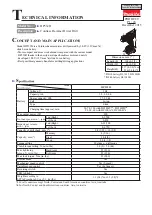
CAUTION:
AVOID “FREE BLOWS” (THE PISTON HITTING THE UNSUPPORTED DRILL), AS THIS
WILL LEAD TO UNNECESSARY HEATING OF THE OIL AND IN THE LONG RUN
DAMAGE BOTH SEALS AND ROCK DRILL.
7.
When drilling without air flushing (use of compressed air), a hollow drill bit with an open air hole
MUST NOT
be
used, as this will cause excessive dust accumulation around the piston causing accelerated wear of the piston and seals.
3.6
PREPARING ROCK DRILL FOR SHUTDOWN
1.
Stop the Rock Drill by releasing the trigger lever.
2.
Stop the hydraulic power source following the procedure in the respective instruction manual.
3.
Disconnect the hoses from the Rock Drill.
WARNING:
NEVER DISCONNECT ANY HYDRAULICALLY OPERATED PART OF THE ROCK
DRILL OR REMOVE HYDRAULIC COMPONENTS, LINES, OR FITTINGS WHILE THE
POWER SOURCE IS RUNNING OR WHENEVER THE HYDRAULIC FLUID IS HOT.
LIQUID UNDER HIGH PRESSURE CAN PIERCE THE SKIN, CAUSING DEATH OR SERIOUS
INJURY. HOT LIQUID CAN CAUSE SERIOUS PERSONAL BURNS. IF AN INJURY OCCURS,
GET IMMEDIATE MEDICAL ATTENTION.
4.
Secure the Rock Drill and hydraulic power source to prevent unauthorized use.
5.
Store the Rock Drill away from excessive heat or moisture. Store in a clean, dry area away from exposure to high
humidity, liquids, or freezing temperatures.
3.7
OPTIONAL WEIGHT BLOCK
The Rock Drill is provided with threaded holes for mounting a weight block or supporting root. When using a weight block
of 25-33 lbs. as additional weight, it is not necessary for the operator to apply any additional feed force. This is particularly
advantageous if the job takes a long time.
3.8
AIR FLUSHING
When air flushing is required, the Rock Drill can be connected to any air compressor with a minimum 14 cfm at 70psi
output. If the holes to be drilled are not deep, and the drilling dust is dry, a small compressor capacity will often be
sufficient, whereas the drilling of deeper holes with moist dust will require a higher compressor in order to achieve
sufficient air flushing.
Connection can be made by means of standard air components and hose with a minimum rating of 145psi (10bar). The
hose diameter should not be less than 1/2” ID in order to prevent pressure loss.
7










































